|
Zaterdag
26 april 2008
Our Hotel "1915" in Alajuela
is not far from the International Airport of San José, the capital of 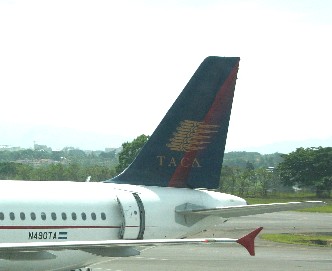 Costa Rica. Breakfast is excellent and for the first time on this trip, not
buffet style. After breakfast we get the car out of the closed compound and
drive to
Budget Car Rental to return the car. Budget is located, together with all the
other major rental firms, close to the Alajuela turn off from the highway. We
return the car, pay the rental charge and are driven to the airport in a shuttle
bus. Before check in we have to pay a departure tax of $26 per person. We fly
with TACA
to Panama City. The flight takes about an hour. In Panama City we rent a
Nissan Sentra from Hertz, a
very ordinary, old fashioned looking family car. We drive into the city via a
chaotic wide road. The Panamese are even less disciplined drivers than the Costa
Ricans. After more than 90 minutes we reach our hotel, Torres de Alba. We
have a spacious apartment. The hotel is located in the Cangrejo district. The
city is busy and warm.
Costa Rica. Breakfast is excellent and for the first time on this trip, not
buffet style. After breakfast we get the car out of the closed compound and
drive to
Budget Car Rental to return the car. Budget is located, together with all the
other major rental firms, close to the Alajuela turn off from the highway. We
return the car, pay the rental charge and are driven to the airport in a shuttle
bus. Before check in we have to pay a departure tax of $26 per person. We fly
with TACA
to Panama City. The flight takes about an hour. In Panama City we rent a
Nissan Sentra from Hertz, a
very ordinary, old fashioned looking family car. We drive into the city via a
chaotic wide road. The Panamese are even less disciplined drivers than the Costa
Ricans. After more than 90 minutes we reach our hotel, Torres de Alba. We
have a spacious apartment. The hotel is located in the Cangrejo district. The
city is busy and warm.
We have break, do our laundry
and go out for a cocktail at Habibi's on Calle Uruguay, the main party drag in
town. We take a taxi for $2 (haggled down from $3). After that we have dinner in
the Greenhouse restaurant, a trendy place but a bit quiet for a Saturday
night.
Weather: in
Panama very warm 35°C/95°F. Sunny
Sunday 27 April 2008
We have breakfast in the
hotel's restaurant. Nothing special, but they do have scrambled eggs. We take
the car out into the direction of Colon. It is quiet on the road. 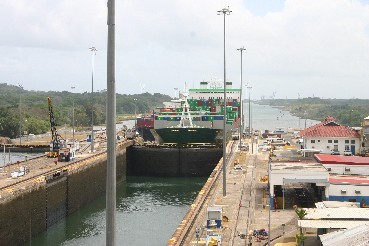 It
takes about 90 minutes before we get to the outskirts of Colon. We do not want
to go to Colon, but to the Gatun Locks in the
Panama Canal on
the Caribbean side. The is not the easiest thing to find. There are no signs
pointing that way. We have to ask a couple of times to get to the right turn off
in the village of Marguerita, towards Gatun. In Gatun we take the wrong
road. Gatun is a former US settlement, clearly given over to neglect when the
Panamese took over control of the Canal Zone in 1999. We have to loop back and
ask again at a gas station. That we have to drive on to a T-junction, take a
left and keep on driving until we see a sign telling us we have arrived at the Gatun Locks.
We take a right to the canal, not making the mistake of lining up with the folks
wanting to cross the canal. WE park the car next to the gift shop and buy a
ticket for the visitors platform ($5). The platforms offers a perfect view of
the locks. A commentator welcomes us and tells us in both Spanish and English
what is going on. One ship after the other is guided through the locks. Every
passage of the locks take 1.5 hours, the total Canal about 10 hours. A
magnificent sight. After watching for about an hour we drive to a Burger King
just outside Colon. We leave Colon for what it is, an unsafe unattractive town.
We drive to Sabanita where we turn left to Portobelo. That is not
signposted either. It takes about 45minutes to get to the erstwhile centre of
the Spanish presence in Central America. It was here that from 1597 onwards the
Spanish royal fleet collected the gold and silver taken from Peru for the
Spanish King. Many English and Dutch pirates tried to capture and ransack the
town or rob the fleet. By the time the Spaniards had improved the town's
defences the gold had run out and the town became unimportant. It
takes about 90 minutes before we get to the outskirts of Colon. We do not want
to go to Colon, but to the Gatun Locks in the
Panama Canal on
the Caribbean side. The is not the easiest thing to find. There are no signs
pointing that way. We have to ask a couple of times to get to the right turn off
in the village of Marguerita, towards Gatun. In Gatun we take the wrong
road. Gatun is a former US settlement, clearly given over to neglect when the
Panamese took over control of the Canal Zone in 1999. We have to loop back and
ask again at a gas station. That we have to drive on to a T-junction, take a
left and keep on driving until we see a sign telling us we have arrived at the Gatun Locks.
We take a right to the canal, not making the mistake of lining up with the folks
wanting to cross the canal. WE park the car next to the gift shop and buy a
ticket for the visitors platform ($5). The platforms offers a perfect view of
the locks. A commentator welcomes us and tells us in both Spanish and English
what is going on. One ship after the other is guided through the locks. Every
passage of the locks take 1.5 hours, the total Canal about 10 hours. A
magnificent sight. After watching for about an hour we drive to a Burger King
just outside Colon. We leave Colon for what it is, an unsafe unattractive town.
We drive to Sabanita where we turn left to Portobelo. That is not
signposted either. It takes about 45minutes to get to the erstwhile centre of
the Spanish presence in Central America. It was here that from 1597 onwards the
Spanish royal fleet collected the gold and silver taken from Peru for the
Spanish King. Many English and Dutch pirates tried to capture and ransack the
town or rob the fleet. By the time the Spaniards had improved the town's
defences the gold had run out and the town became unimportant. 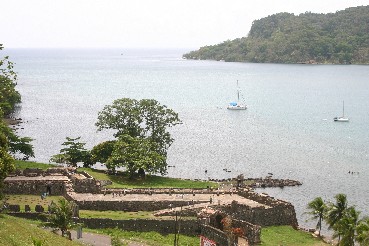 The
new fortifications were never put to the test. Columbus was the first European
to visit these shores on his fourth journey to the New World in 1502 and gave it
its name ("Beautiful harbour"). The
new fortifications were never put to the test. Columbus was the first European
to visit these shores on his fourth journey to the New World in 1502 and gave it
its name ("Beautiful harbour").
We visit what remais of the Santiago
and Jeronimo fortresses. The Americans used stones from the fortresses for the
construction of the Panama Canal, which is why the fortress a in ruins.
Jeronimo is best preserved. The Real Aduana (Royal Customs House) is another
sight. In this building the gold was weighed, accounted and stored for the
yearly visit of the Spanish fleet. 233 soldiers guarded the building. It
contains a museum with two rooms. One with a videopresentation and a decent
exhibition of the history of the place. The other room holds a collection of old
weapons. The upper floor with veils for the black Christ statue, who is honoured
in October, is not accessible. The Black Christ is the centre of a huge
procession and festival in October. .
Today is a Sunday and the
mainly black population hangs around the village square and campaigners for a
female presidential candidate for next year's elections plays loud salsa
music.
Around 3pm we head back to
Panama, where we get to our apartment around 5. We have dinner at restaurant Machu
Pichu. Good food, and not expensive at all. Two coarses and wine for $49
Weather: sunny and warm. 32°C
/ 90°F.
Maandag
28 april 2009
We drive out of town towards
Gamboa. 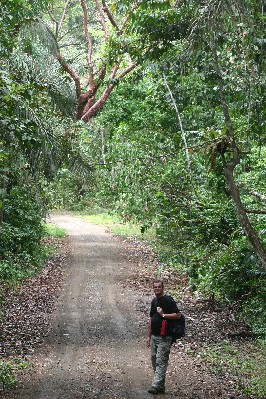 It is difficult to find the right turn off from the Northern ring road. We drive
to Gambo, once a US settlement. Now it is home to the Smithsonian Institute
which does a lot of research in the rain forests here. We have to drive a fair
bit further to get to the start of the Sendero de Oleoducto, the Pipeline Road,
a 16km long walking trek in the Soberania National Park . We should be
able to see lots of birds here. At the start we do not see an awful lot, but we
do hear the howler monkeys. Afther about an hour it starts raining. After two
short showers we some small birds. After an hour and a half we turn round. When
we almost back at our starting point we see an
It is difficult to find the right turn off from the Northern ring road. We drive
to Gambo, once a US settlement. Now it is home to the Smithsonian Institute
which does a lot of research in the rain forests here. We have to drive a fair
bit further to get to the start of the Sendero de Oleoducto, the Pipeline Road,
a 16km long walking trek in the Soberania National Park . We should be
able to see lots of birds here. At the start we do not see an awful lot, but we
do hear the howler monkeys. Afther about an hour it starts raining. After two
short showers we some small birds. After an hour and a half we turn round. When
we almost back at our starting point we see an  Agouti
and two Tucans. Agouti
and two Tucans.
We drive to the Miraflores
Locks in the Panama Canal. These locks are on the Pacific side of
the Canal. Half way through we drive past the San Pedro Locks. At
Miraflores we see a movie about the history of the Canal and its construction.
From the viewing platform we can see the ships passing through. There are not
many ships passing this time.
We drive back to our hotel.
That is easy enough. We have a shower and freshen up. Then we are on our way to
the Causeway connecting a couple of islands to the mainland. The islands are
located near the entrance of the Canal. From there we have a great view of the
City's skyline. The shopping centre at Isla Flamengo is a disappointment. All
the shops are empty except for a few restaurants. We have a salad and some wine
while we enjoy the view. On our way back we pelicans plunging into the water,
hunting for fish.
We return the car at the Hertz
office across from our hotel. At night we eat at the wine bar next to our
hotel.
Weather: some cloud with sunny
spells. Two showers during the morning hours. 31°C / 88°F
Tuesday
29 April 2008
We are being picked up from our
hotel and driven to Allbrook airport by René Guardiola of yourmaninpanama.com.
From this former US Airforce base only domestic flights are oporated. We check
in with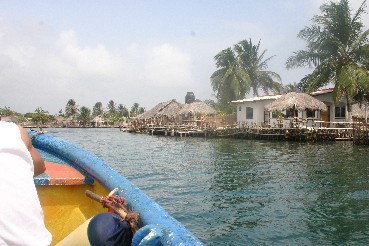 Air
Panama after a cursory inspection of our baggage. We have to wait until
7.30. Suddenly a indian looking young man appears and asks whether I am
Eddy travelling to San Blas. He will look after us he says. When we have to
report for our flight he tells us to stand in line and disappears. We board the
tiny aircraft, which is fully booked with 18 passengers. We fly for 40 minutes
when we land on a small airfield. We get out, but do not see our baggage being
offloaded. Then it turns out that we have left the aircraft a few stops too
early. After another 15 minutes of flight and one more stop we land on the
tiny airstrip of Achutupo. Achutupo is part of the San Blas archipelago,
which itself is part of the autonomous province Comarca de Kuna Yala. There are
about 360 islands of which 50 are inhabited. The coastal area on the mainland is
also part of the Comarca, but nobody lives there. Only the airfields are there.
The Panamese granted full autonomy back in 1925. The Kuna indians originally
lived in both Colombia and Panama, but after the arrival of the Spanish in the
16th century and conflicts with other indian nations the Kuna withdrew to these
islands. We are welcomed by our hosts and guides Ariel and Lonny. They take us
in their boat to the Dolphin Lodge on Uaguitupo. We are the only
guests today on this bounty like island. We have breakfast with the sea around
us. After a short break our guides take us to Achutupo by boat. 1800 Kuna live
here in simple conditions. We walk through the village and are being approached
constantly by women who want to sell their Molas. Those are hand
Air
Panama after a cursory inspection of our baggage. We have to wait until
7.30. Suddenly a indian looking young man appears and asks whether I am
Eddy travelling to San Blas. He will look after us he says. When we have to
report for our flight he tells us to stand in line and disappears. We board the
tiny aircraft, which is fully booked with 18 passengers. We fly for 40 minutes
when we land on a small airfield. We get out, but do not see our baggage being
offloaded. Then it turns out that we have left the aircraft a few stops too
early. After another 15 minutes of flight and one more stop we land on the
tiny airstrip of Achutupo. Achutupo is part of the San Blas archipelago,
which itself is part of the autonomous province Comarca de Kuna Yala. There are
about 360 islands of which 50 are inhabited. The coastal area on the mainland is
also part of the Comarca, but nobody lives there. Only the airfields are there.
The Panamese granted full autonomy back in 1925. The Kuna indians originally
lived in both Colombia and Panama, but after the arrival of the Spanish in the
16th century and conflicts with other indian nations the Kuna withdrew to these
islands. We are welcomed by our hosts and guides Ariel and Lonny. They take us
in their boat to the Dolphin Lodge on Uaguitupo. We are the only
guests today on this bounty like island. We have breakfast with the sea around
us. After a short break our guides take us to Achutupo by boat. 1800 Kuna live
here in simple conditions. We walk through the village and are being approached
constantly by women who want to sell their Molas. Those are hand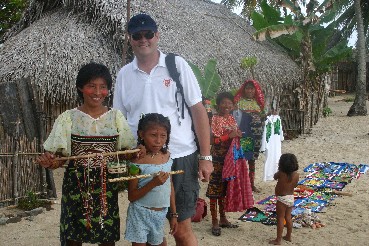 embroidered cloths with traditional designs in bright colours. We see the entire
village, the ceremonial cabin, the school and the police station. There is no
electricity, but there is a phone. Some people have their own generator. A few
shops sell the basic necessities. The men are absent in the village. They are
out fishing or tending their crops on the mainland. You cannot live on the
mainland, because it is infested with mosquitoes who become active at night.
Most people do not have monetary income, but live from the fish they catch and
the fruits and vegetables they grow. The fishing is done with canoes made out of
long trees. The Kuna get them by trading them for Coconuts with Indian tribes in
Colombia. Colombian ships call regularly on the islands to barter goods for
coconuts and other goods. Non-Kuna are not allowed to establish themselves on
the islands. Modern fishing techniques are not allowed nor is scuba diving with
oxygen tanks.
embroidered cloths with traditional designs in bright colours. We see the entire
village, the ceremonial cabin, the school and the police station. There is no
electricity, but there is a phone. Some people have their own generator. A few
shops sell the basic necessities. The men are absent in the village. They are
out fishing or tending their crops on the mainland. You cannot live on the
mainland, because it is infested with mosquitoes who become active at night.
Most people do not have monetary income, but live from the fish they catch and
the fruits and vegetables they grow. The fishing is done with canoes made out of
long trees. The Kuna get them by trading them for Coconuts with Indian tribes in
Colombia. Colombian ships call regularly on the islands to barter goods for
coconuts and other goods. Non-Kuna are not allowed to establish themselves on
the islands. Modern fishing techniques are not allowed nor is scuba diving with
oxygen tanks.
We go back to hour hotel for
lunch. In the afternoon we go to an even smaller island to do some snorkeling on
a coral reef. Erik's mask does not fit very well, but mine does. We swim to the
reef from the beach.
Back in the hotel we have the
dinner room to ourselves. The bartender has bought some cans of club soda, after
having to disappoint us earlier today. We take wine with our dinner. Fish of
course, freshly caught today.
Weather: light clouds, sunny
periods. 30°C / 86°F
Wednesday 30 April 2008
While our fellow countrymen back home are celebrating the Queen's official birthday we have got a new
neighbour, and elderly woman from the US. We finish our breakfast just before it
starts thunder and rain. It lasts all morning. After lunch we take the boat out
to Ailigandi, a bigger island. On our way there we get some more rain, but we
persist. In the village we go to a cultural centre where Kuna children learn
traditional crafts and music in order to maintain the traditions. We also see
the chief or Sahila, who hands out justice and advise
back home are celebrating the Queen's official birthday we have got a new
neighbour, and elderly woman from the US. We finish our breakfast just before it
starts thunder and rain. It lasts all morning. After lunch we take the boat out
to Ailigandi, a bigger island. On our way there we get some more rain, but we
persist. In the village we go to a cultural centre where Kuna children learn
traditional crafts and music in order to maintain the traditions. We also see
the chief or Sahila, who hands out justice and advise stretched out in a hammock. The Sahila has great knowledge of the traditions of
the nation and knows traditional chants by heart. We are not allowed to take
pictures of him. From all other islanders we can take pictures. Contrary to
Achutupo where each photo costs $1. On this island we pay a visitors tax of $3
and that's it. We visit a hospital, a school and a museum belonging to a Kuna
artist who makes traditional scenes out of woodcarvings and paintings.
After two hours we return to the hotel..
stretched out in a hammock. The Sahila has great knowledge of the traditions of
the nation and knows traditional chants by heart. We are not allowed to take
pictures of him. From all other islanders we can take pictures. Contrary to
Achutupo where each photo costs $1. On this island we pay a visitors tax of $3
and that's it. We visit a hospital, a school and a museum belonging to a Kuna
artist who makes traditional scenes out of woodcarvings and paintings.
After two hours we return to the hotel..
In the lodge we have dinner
after which the hotel staff puts on a show. First a representation of the legend
of the man who learned the Kuna fish, hunt, farm and their handicraft. After
that a traditional dance. It is a bit amateuristic, but nice nevertheless.
We go to bed early, because we
will have an early start tomorrow
Weather: rain and heavily
overcast 25°C / 77°F
|

